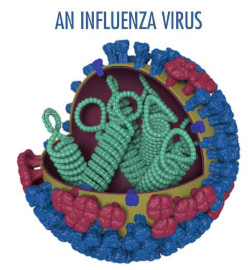
| Jan. 2019 | |||||||||||
| Top stories | |||||||||||
| In the news | |||||||||||
| Photos | |||||||||||
| Contact us | |||||||||||
| Archive | |||||||||||
|
Flu is widespread across Iowa and much of U.S. |
Jan. 31, 2019 --
As the nation enters the mid-way point of what appears to be a typical influenza season, the Centers for Disease Control and Prevention reports that as of Jan. 12, Iowa and nearly 30 other states have widespread incidence of flu.
 An influenza virus
An influenza virus
Although the case count increased this month, the 2018-2019 season is not expected to be as severe as 2017-2018. That year, an estimated 80,000 people in the U.S. died from influenza-related illnesses compared to an annual range in recent years from roughly 12,000 deaths during 2011-2012 to approximately 56,000 in 2012-2013.
The Iowa Department of Public Health (IDPH) estimates that at this point during the 2017-2018 season, there were 29 adult influenza-related deaths in Iowa. No pediatric flu-related deaths were reported that season. As of Jan. 24, 2019, three confirmed adult deaths have been reported for the current season.
“Last year was a high severity influenza season in Iowa and most of the United States, with activity from November through the end of March, and a long period of very high activity. Influenza A (H3N2) was the predominant strain circulating,” said Jeff Benfer, State Hygienic Laboratory supervisor of Molecular Biology and Virology.
“Typically, in years that influenza A (H3N2) circulates, vaccine effectiveness is low and severity of illness and deaths are high. Also, a relatively high level of influenza A (H1N1) pmd09 and influenza B co-circulated last season. This season, influenza A (H1N1) pmd09 is predominating and we are seeing a much more mild flu in Iowa; however, that could still change which is why we will continue to monitor influenza.”
Benfer explains that SHL influenza surveillance contributes to state, national and global goals by
- helping to determine when and where influenza is circulating in the state;
- identifying virus strains for further characterization;
- considering if the current vaccine is a good match to what is circulating;
- contributing to the selection of next year’s vaccine;
- identifying novel strains and zoonotic transmissions; and
- monitoring for resistance to drugs that treat influenza.
SHL also collects respiratory data via an online survey tool. Each week it surveys more than 100 sentinel laboratories throughout Iowa for rapid (both antigen and PCR based) influenza and other respiratory pathogens, including respiratory syncytial virus (RSV) test results. This data is part of a statewide summary that is reported back to submitters and is included in the weekly IDPH Surveillance Report.
Earlier this year, it was announced that SHL and IDPH are collaborating on a new influenza project funded by the Council of State and Territorial Epidemiologists. This project is expected to better estimate the burden of disease in real-time by measuring how much respiratory illness is caused by flu versus other respiratory pathogens, identifying the level of care associated with influenza positive specimens tested at SHL, and providing better estimates of population based rates of influenza.
SHL is part of the IDPH Iowa Influenza Surveillance Network that reports strains of flu and where they are circulating in the state.
"SHL greatly appreciates the partnership with clinical laboratories throughout Iowa who faithfully submit specimens so that further characterization of strains can be performed," said SHL Director Dr. Michael Pentella. "This collaboration demonstrates the importance of all clinical laboratories in the public health system."
Weekly activity numbers for Iowa and a national influenza summary are available on the IDPH Flu Report web page. More detailed reports that include state-by-state flu activity are reported by CDC on its FluView page.
Flu reports on both websites are identified by calendar year. For example, for the week ending Jan. 12, 2019, the report is named "Flu Report – Week 2." The summary for Oct. 27, 2018 – roughly when this season’s flu season began – is identified as "Flu Report – Week 43."